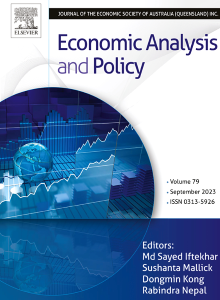The Impact and Mechanism of Government Environmental Policy Innovation on Industrial Agglomeration: An Empirical Study Based on a Quasi-Natural Experiment of the River Chief System Policy in the Yangtze River Economic Belt
IF 7.9
2区 经济学
Q1 ECONOMICS
引用次数: 0
Abstract
The Yangtze River Economic Belt pioneered the implementation of the River Chief System Policy (RCSP), where the government takes comprehensive responsibility for the water environment of the river basin to address water pollution issues. This policy has been promoted nationwide as a successful model of environmental governance. However, what impact does the RCSP implementation have on economic agglomeration, an important mode of economic growth? How does it exert this influence? Based on the implementation of the RCSP, this study establishes a quasi-natural experiment. Theoretical analysis is conducted using the Footloose Entrepreneur (FE) model, and empirical tests are performed using the difference-in-differences (DID) method and the mediation effect model. Additionally, robustness checks are conducted from multiple perspectives. Empirical results indicate that the RCSP significantly inhibits industrial agglomeration in the Yangtze River Economic Belt. This influence operates through three mediating mechanisms: industrial wastewater discharge, green technological innovation, and foreign direct investment. As a targeted water environmental regulation, the mediating mechanism of reducing the comprehensive environmental pollution index is not significant. The study also reveals heterogeneity in the spatial effects of the RCSP's inhibitory impact on industrial agglomeration, with stronger effects observed in regions with higher levels of marketization.
政府环境政策创新对产业集聚的影响及机制——基于长江经济带河长制政策准自然实验的实证研究
长江经济带率先实施河长制政策(RCSP),由政府对流域水环境全面负责,解决水污染问题。这一政策作为环境治理的成功典范在全国范围内推广。然而,RCSP的实施对经济集聚这一重要的经济增长方式产生了怎样的影响?它是如何发挥这种影响的?基于RCSP的实施,本研究建立了一个准自然实验。采用Footloose Entrepreneur (FE)模型进行理论分析,采用差分法(DID)和中介效应模型进行实证检验。此外,从多个角度进行鲁棒性检查。实证结果表明,RCSP显著抑制了长江经济带的产业集聚。这种影响通过三种中介机制发挥作用:工业废水排放、绿色技术创新和外国直接投资。作为一项针对性的水环境调控,降低环境综合污染指数的中介机制不显著。研究还揭示了RCSP对产业集聚抑制效应的空间异质性,市场化程度越高的地区抑制效应越强。
本文章由计算机程序翻译,如有差异,请以英文原文为准。
求助全文
约1分钟内获得全文
求助全文
来源期刊

Economic Analysis and Policy
ECONOMICS-
CiteScore
9.80
自引率
9.20%
发文量
231
审稿时长
93 days
期刊介绍:
Economic Analysis and Policy (established 1970) publishes articles from all branches of economics with a particular focus on research, theoretical and applied, which has strong policy relevance. The journal also publishes survey articles and empirical replications on key policy issues. Authors are expected to highlight the main insights in a non-technical introduction and in the conclusion.
 求助内容:
求助内容: 应助结果提醒方式:
应助结果提醒方式:


